The Great Earthquake in Japan
Tokio, Nov.7th. 1891
Ten days ago, as the world has doubtless been told briefly by telegram, the whole of Central Japan was convulsed by an earthquake of very uncommon severity.
The particulars of the phenomenon, of its fearful potency and far-reaching effects, are gradually coming to light, and enough is now known to make it only too clear that the catastrophe of the 28th ult. must be ranked as one of the most terrible in seismic records.
No fewer than 31 provinces of Japan were more or less violently agitated.
In other words, the earth's crust was smartly shaken for several minutes together over an area equal to that of England.
Beyond this area the shocks were slighter.
Yet sensible movements extended to the far north of the main island, 400 miles from the origin, and again to a similar distance south-westward, where the earth-throes, passing under the sea, invaded the neighboring island of Kiushu.
Even here in Tokio, distant some 170 miles as the crow flies, from the centre of disturbance, the earthquake was the greatest that has been experienced since the founding of the observatory in 1874; there has, in fact, been nothing like it since the great Yedo earthquake of 37 years ago.
It lasted 12 minutes, and the ground surface at the observatory attained a maximum horizontal or back-and-forth movement of 2 in., combined with a vertical movement of three-eights of an inch.
Happily little harm was done hereabouts, as the vibrations, though of great amplitude, were of an easy, swinging kind.
A few chimneys were wrecked and roofs injured, and there were the usual stopping of clocks, swinging of lamps and pictures, and upsetting of small movables.
But people in the capital and Yokohama were more frightened than hurt, and not a life was lost.
From the region of greatest activity, on the other hand, come woeful accounts of wholesale destruction of life and property, rendered all the more impressive by its appalling suddenness.
There, within an area of some 500 square miles and in the space of half a minute, more than 3,500 people were crushed to death under the ruins of falling houses, and about 4,500 others were more or less injured; while the buildings totally overthrown had to be numbered by tens of thousands.
Heavy as is this record of death and havoc, it was enormously swelled, later on, by the fall of tiles and other wreckage, and of tottering buildings, under the effects of subsequent milder shocks, and especially by the ravages of fire, which is always sush a terrible concomitant of great earthquake calamities in Japan.
Hundreds upon hundreds of lives were sacrificed by the burning to death, before rescue was possible, of sufferers entangled or buried beneath the ruins of their dwellings.
Lots of property was swelled from the same cause, fire proving in some cases as fatal to property as even the earthquake itslef.
Roughly speaking, the area of maximum disaster measures 25 miles from north to south by 20 miles from east to west, and is contained in the provinces of Mino and Owari, the whole of which suffered more or less cruelly by the catastrophe.
But death and devastation were by no means confined to them.
In Echizen, for example, bordering Mino on the north, the number of killed and wounded amount to 68, while some 700 buildings were demolished or badly damaged.
Again, in Osaka, 75 miles to the south-west, where the horizontal surface movement is said to have reached four inches, there was serious destruction, and the fall of a cotton-spinning factory killed 35 workpeople and wounded 220.
To sum up the whole fruits of this latest manifestation of the earth's plutonic energy, the figures thus far arrived at show that fully 8,000 people have perished by horrible deaths, the wounded numbering about 10,000; and that, to 84,000 houses demolished by the earthquake, must be added 5,000 afterwards destroyed by fire, and at least 20,000 reduced to various states of dilapidation.
More than 300,000 people have been suddenly rendered homeless, and to many of these the calamity means, for the time at least, virtual destitution.
Viewed side by side with these dismal totals, the effects on life and property of the great Bandaisan explosion, which I described in The Times some two years ago, are dewarfed to insignificance.
Death or some form of misery has in the present case fallen on perhaps half-a-million souls.
Parents and brethren, wives, husbands, and children, have been lost, and the ruined survivors, desolate and houseless, "mourn," as a Japanese writer puts it, in thousands "by the wayside."
Nor do the facts cited above by any means tell the whole tale of disaster.
To them must be added damages of almost incalculable value inflicted upon roads, bridges, railways, embankments, and the land and crops in general.
In some places landslips have dammed the streams, creating lakes or producing inundations ; hundreds of wells have been destroyed; springs have ceased flowing; and the embankments of the larger rivers have been so grievously damaged that a heavy rainfall might at any time lead to disastrous flooding of the adjacent lowlands.
Involved in the widespread ruin are the famed potteries of Owari and Mino.
By their destructin the chief porcelain-making colony in Japan has been brought to a condition of idleness which must be of some months' duration.
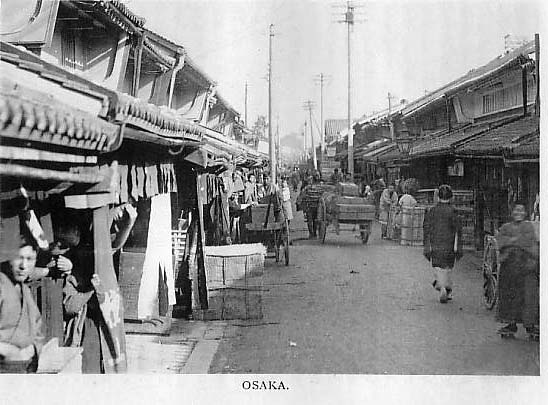
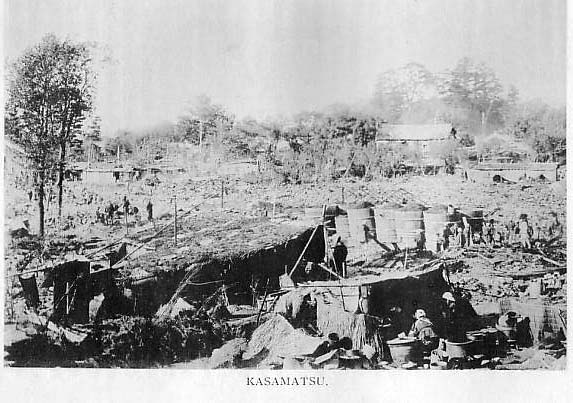
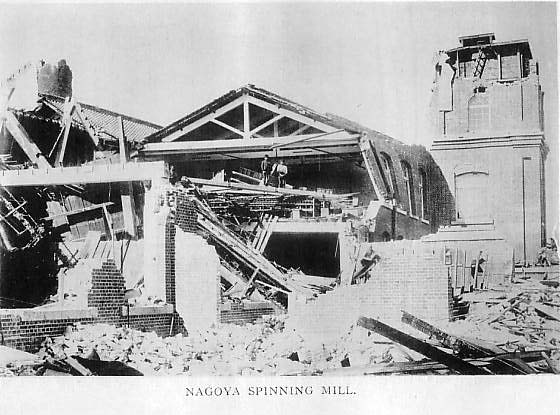
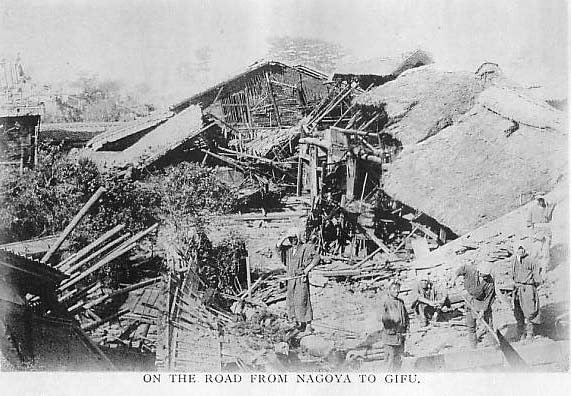
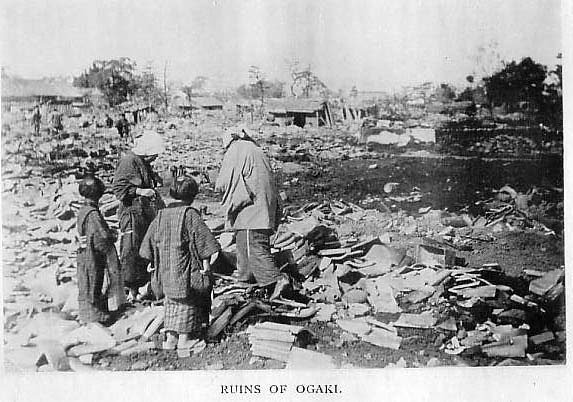
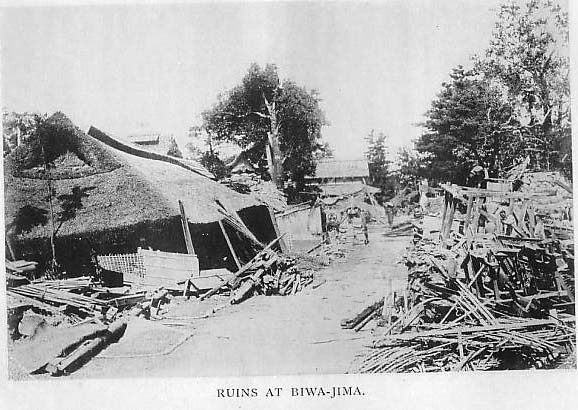
The area of maximum effect to which I have referred is a part of the great fertile and thickly-populated plain which lies between the Mino hills and the head of the Owari Gulf.
Near its southern border is Nagoya, the fourth city of Japan, with a population of 162,000.
Near its southern border is Gifu, till the other day a busy manufacturing town of some 30,000 inhabitants.
After these come, or at least came, Ogaki, Kano, Kasamatsu, and other lesser towns, and scores of villages and hamlets, many of which, since the fatal 28th, have existed only in name.
The seat of origin of the earthquake is believed to be about 12 miles from Gifu, where a large area is reported to have subsided bodily and to have undedrgone other great physical changes.
This remains to be verified.
It is as yet early to write on that part of the subject.
But that the focus cannot be far from Gifu is established by the fact that there and thereabouts the destroying power was greater than in any other peopled district.
Nagoya, nevertheless, and its suburb, Atsuta, suffered very heavily indeed.
Thousands of houses collapsed, and there are few without damage of some kind, while death and injury reigned in every quarter.
The great earthquake began at about 6.30 a.m., and it came without previous warning.
As far as can be gathered from the accounts of survivors who were present, its chief features were two very severe shocks in quick succession, with an eastward throw - the second greater than the first - followed immediately by a yet stronger return wave, or back-throw, directed westward.
It was this third shock, they say, that wrought most of the earlier mischief.
But so violent and awfully sudden were the phenomena that the scared folk who experienced them can hardly, in the nature of things, be expected to have very clear ideas of what took place.
On the other hand, as observatories and apparatus in the area of chief disturbance were overwhelmed in the general ruin, instrumental records of the nature and exact times of the movements there unfortunately do not exist.
Some people tell how they were thrown headlong downstairs; others that they could neither walk nor stand.
Numbers of girls and women seem to have burst out crying.
An American officer who was staying in Nagoya at the time had to grasp the framework of his bed to prevent his being thrown out on to the floor.
An Englishman, jumping up from bed, was pitched through the sliding windows of his room into the verandah.
That there was violent heaving as well as vibration is certain.
One observer claims to have determined a vertical motion of 8-1/2 inch, and a horizontal motion of a foot.
But this statement must be received with caution.
The great shocks at the outset, and the chief shocks for several days after, were immediately preceded by a deep muffled booming, as from distant ordnance down in the bowels of the earth.
The fact of this sound preceding the shocks indicates that the velocity of propagation of the latter through that part of the earth's crust was less than the velociy of sound.
Sometimes there was sound without shocks, showing that the latter lacked either energy or direction to reach the hearers.
The painful scenes in the streets directly after the great shocks may be imagined, but can hardly be described.
Though the demeanour of the survivors was sober and reasonable to a degree impossible to any people but the gentle and sunny-hearted Japanese, the groans of the wounded and dying under the piles of wreck, the lamentations of those who were left over those who had been taken, and the further death and ruin that were ever being dealt out by shock after shock in rapid succession - less severe than the first throes, yet strong enough to finish much that they had left undone - made up a scene of horror fit indeed to appal the stoutest hearts.
It was a scene, nevertheless, in which even the most dazed and grief-stricken of the afflicted survivors bore themselves with wonderful fortitude, resignation, and patience.
The same qualities were throughout displayed by the townsfolk and villagers generally during the days and nights of terror and wretchedness that were inflicted upon them, in Nagoya and everywhere in the devastated region, by the protracted manifestations of plutonic activity, which, indeed, are still going on.
Upwards of 6,600 earth spasms of greater or less energy were felt in Nagoya during the 206 hours after the first outbreak.
That is to say, there was an average during that period of more than 30 shocks an hour.
And, inasmuch as the intervals between the shocks steadily increased, the frequency in the earlier days of the period probably amounted to about a shake every minute.
It is little wonder, then, that not only the houseless, but thousands who, though their dwellings still stood, had not the courage to re-occupy them as long as the earth kept quaking under their feet, were driven to camp in the open, in the streets.
There, in the rudest of shelters, made with screens, shutters, mats, and even mosquite curtains, men and women, maidens, youths, and children, dwelt, despite discomfort and cold nights, for a full week after the disaster - sad at heart no doubt, yet outwardly contented and even cheerful, quietly bidding the time till mother earth's tyranny should be overpast.
On advancing from Nagoya towards Gifu the signs of ruthless havoc are seen to grow in number and intensity, and the surface is found to be seamed with long fissures, running mostly north and south.
It is curious, nevertheless, to see that the worst effects were partial, areas comparatively unscathed being mixed up in the strangest way with scenes of awful destruction.
The long road of 19 miles, most of it lined formerly with houses and villages, is now for the greater part of its length a mere lane between heaps of ruins.
Gifu itself is one big wreck, looking as if it had undergone a fierce bombardment.
Here the destruction by fire was terrible.
Fully one-half of the houses are gone.
Ogaki, nine miles to the west, fared even worse.
There, of 4,434 houses that constituted the town, 3,556 were destroyed and 765 were partly ruined, leaving only 113 unscathed.
The killed and wounded numbered about a tenth of the population.
In one temple alone, all but two of a congregation of 150 assembled for the early service were crushed or burned to death.
The whole region, indeed, about Gifu and Ogaki bears the marks of fearful convulsion.
Many villages and small towns were absolutely wiped out, not a house being left standing.
In places the soil sank several feet over considerable areas, sometimes carrying down with it houses and their inmates.
Earth-fissures are seen everywhere, some of them, as many as six feet wide and twenty or more feet deep.
The effects produced on engineering structures are in many cases extraordinary.
One brick railway-arch between Nagoya and Gifu collapsed in consequence of its abutments, 14 ft. high and 5-1/4 ft.thick, having been thrown apart in opposite directions.
The roadway beneath has a transverse crack four inches wide.
Three great railway bridges within a radius of six miles from Gifu, crossing the rivers Kisogawa, Nagaragawa and Ibigawa, have suffered badly, the massive piers of brickwork or iron having been broken across, though the iron girders, of English make, withstood their terrible treatment wonderfully.
All of these bridges were thoroughly good, strong structures, and have been in use for five years without suffering in any degree from such potent destructive agencies as the fierce typhoons and river floods of Japan.
The minor bridges throughout this district have also been wrecked in various ways and degrees.
And generally, from its effects on engineering and other structures, the earth-movement on the 28th seems to have been at least as violent and extreme as that of any earthquake in the history of mankind.
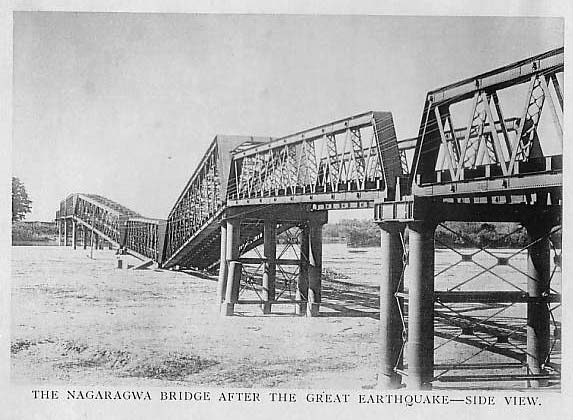
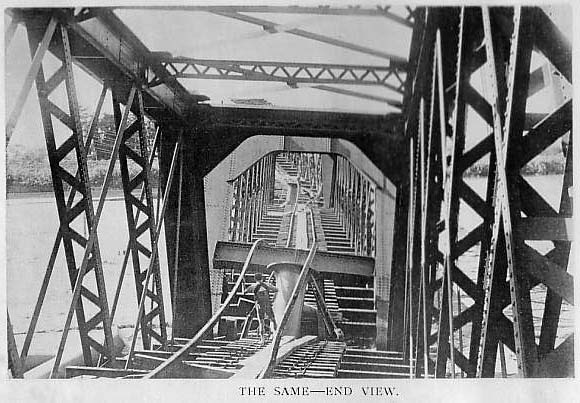
If anything could aggravate the horrors of the great catastrophe thus described, it would be its wholly unexpected advent.
Seimic convulsions are seldom, if ever, forecast, even in districts where more or less risk is always present.
But in this case the circumstances were such as to place the anticipation of danger beyond the bounds of ordinary human foresight.
The Nagoya plain lies in a region essentially non-volcanic, and for more than a thousand years that part of Japan has shown a marked falling-off in seimic activity - so much so that it had come to be regarded in recent times as a practically safe area, free from liability to any but unimportant earthquake throes.
Upon a population lulled into this belief the outburst on the terrible morning of the 28th - when Nature almost seemed bent on the bold attempt to produce a volcano itself in that non-volcanic region - must have inflicted a shock of surprise proportioned to their previous feeling of security.
And it found them, of course, even more utterly unprepared than they might have been if the locality had been more open to distrust.
It is already recognized that, had such precautions as the building laws proper to earthquake areas been in force, much of the damage might have been averted-not in the central region of disturbance, where the destroying powers were so irresistible, but at least in the outer area, where it is found that destruction has been practically limited to old, ricketty, or rotten edifices.
Generally, the effects of the earthquake confirm accepted theories in some respects, and in others teach new lessons.
Taper mill-chimneys, for example, were broken across the middle-which was to be expected, their tops being free to sway-just as a carriage whip may be snapped in half by violent back-and forth jerking.
Bridge-columns, on the other hand, being of uniform section and loaded, went, naturally, at the base.
The fine old castle of Nagoya is almost unharmed - a fact due, doubtless, to its shape, which is somewhat that of a pyramid in decreasing stages, as well as to the immense strength of its walls, and to the girdle of protection afforded by its deep, wide moat.
Many of the more solidly-built temples also showed wonderful powers of resistance.
Among the lessons taught by the earthquake is an important one bearing on seismometry.
The experience on this occasion, Professor Milne tells me, confirms an idea he has long entertained - that whenever vertical movement takes place it means that ocean-like waves are passing beneatrh our feet, and that what have to be measured in order to determine this motion are the angular tips of the surface, for which a new class of instruments must be devised.
It would have been interesing if means had existed for ascertaining the times of propagation of the great shocks to distant points in the surrounding region.
But, for the reason already given, no trustworthy time-records at or near the origin were possible.
A curious feature observed at Nagoya is the heaping of the tiles, on some roofs still erect, in waves with their crests lying approximately north and south-that is, in lines perpendicular to the direction of the earthquake-throes.
The behaviour of buildings and of the fragments thrown from them also affords an interesting field of reseach, and gives evidence of extraordiary twisting and rotation.
Gradually, full information on these and kindred matters, already being investigated by experts on the spot, will doubtless be given to the world.
The opportunity of adding to our knowledge is a rare one, and it is to be hoped that engineers and architects at home will avail themselves of the valuable data that will soon be put before them.
Not only are some of Great Britain's possessions liable to serious seismic agiatation, but English professional aid and English capital are largely employed in engineering concerns in the earthquake-ridden territories of other nations.
It only remains to say that the relief of the distress and bodily suffering caused by this great national calamity is being actively and liberally carried out, in part by public funds held available for such purposes, and in part by a national subscription, to which will be added substantial contributions by the foreign residents.
The Emperor and Empress generously gave $26,000 for the same purpose as soon as the terrible scope of the disaster became known to them.
The Times: 1891-Dec.8th
Going Back to Article List
